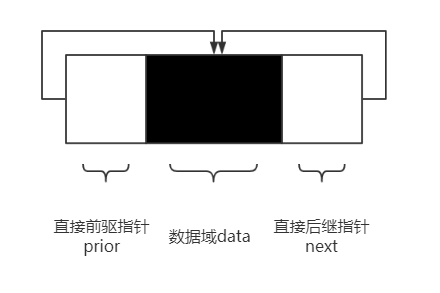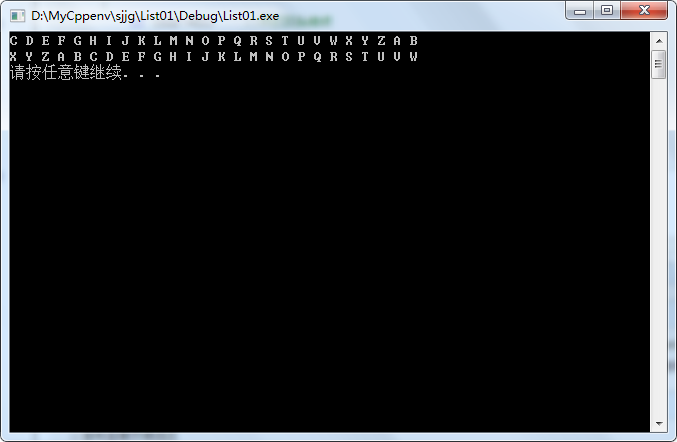双向链表是在单链表的每个结点中,再设置一个纸箱其前驱结点的指针域
typedef struct Node
{
ElemType data;
struct Node* prior; //直接前驱指针
struct Node* next; //直接后继指针
}Node;
typedef struct Node* CLinkList;
对于非循环的,直接将头结点的直接前驱指针置为空,将尾结点的直接后驱结点置为空即可
#define _CRT_SECURE_NO_WARNINGS
#include <stdio.h>
#include <stdlib.h>
#include <time.h>
#include <math.h>
#define OK 1
#define ERROR 0
#define TRUE 1
#define FALSE 0
typedef char ElemType;
typedef int Status;
typedef struct Node
{
ElemType data;
struct Node* prior; //直接前驱指针
struct Node* next; //直接后继指针
}Node;
typedef struct Node* DLinkList;
//四个基本操作,初始化,清空,获取长度,是否为空
Status InitList(DLinkList* Dl);
Status ClearList(DLinkList* Dl);
int GetLength(DLinkList Dl);
Status EmptyList(DLinkList Dl);
//四个插入,程序,删除操作
Status GetElem(DLinkList Dl, int i, ElemType* e);
int LocateElem(DLinkList Dl, ElemType e);
Status InsertList(DLinkList* Dl, int i, ElemType e);
Status DeleteList(DLinkList* Dl, int i, ElemType* e);
//打印链表
void PrintList(DLinkList Dl, int i);
int main()
{
DLinkList dbList;
ElemType e='A';
int i = 0;
InitList(&dbList);//初始化链表
for (; i < 26;i++) //插入数据
{
//InsertList(&dbList, -1, e + i); //尾插法
InsertList(&dbList, GetLength(dbList)+1, e + i); //头插法
}
PrintList(dbList, 3);
PrintList(dbList, -3);
system("pause");
return 0;
}
//四个基本操作,初始化,清空,获取长度,是否为空
//创建一个带有头结点的双向链表
Status InitList(DLinkList* Dl)
{
DLinkList Dlist;
*Dl = (DLinkList)malloc(sizeof(Node));
if (*Dl == NULL)
return ERROR;
(*Dl)->next = (*Dl)->prior = (*Dl); //都指向头结点,虽然这里数据data为char,也是可以存储链表长度的,但是这里不使用
return OK;
}
//清空双向链表,头结点也释放掉
Status ClearList(DLinkList* Dl)
{
DLinkList Dlist = *Dl;
DLinkList q;
if (Dlist == NULL)
return ERROR;
//先将尾结点的next指针置为空,一会作为判断循环退出条件
Dlist->prior->next = NULL;
while (Dlist)
{
q = Dlist;
Dlist = Dlist->next;
free(q);
}
return OK;
}
//获取链表长度,不含头结点,使用一条单向指针域即可
int GetLength(DLinkList Dl)
{
DLinkList cur = Dl->next;
int length = 0;
while (cur!=Dl)
{
cur = cur->next;
length++;
}
return length;
}
//判断是否链表为空,判断头结点一个指针是否指向自己就可以
Status EmptyList(DLinkList Dl)
{
if (Dl->prior == Dl)
return TRUE;
return FALSE;
}
//四个插入,程序,删除操作
//根据索引获取数据,支持双向索引
Status GetElem(DLinkList Dl, int i, ElemType* e)
{
int j = 0;
DLinkList cur = Dl;
if (e == NULL||i==0)
return ERROR;
for (; j < abs(i);j++)
{
if (i < 0)
cur = cur->prior;
else
cur = cur->next;
}
*e = cur->data;
return OK;
}
//按照元素进行查找,单向正向查找
int LocateElem(DLinkList Dl, ElemType e)
{
DLinkList cur = Dl->next;
int index=1;
while (cur->data != e&&cur != Dl)
{
cur = cur->next;
index++;
}
if (cur == Dl)
return 0;
return index;
}
//支持双向插入
Status InsertList(DLinkList* Dl, int i, ElemType e)
{
DLinkList cur = *Dl;
DLinkList newNode;
int j = 0;
if (*Dl == NULL || abs(i) > GetLength(*Dl) + 1 || i == 0)
return ERROR;
for (; j < abs(i);j++) //找到他的后一个节点,一会向前推
{
if (i < 0)
cur = cur->prior;
else
cur = cur->next;
}
//创建一个新的结点
newNode = (DLinkList)malloc(sizeof(Node));
newNode->data = e;
if (i<0)
{
newNode->next = cur->next;
newNode->prior = cur;
cur->next->prior = newNode;
cur->next = newNode;
}
else
{
newNode->next = cur;
newNode->prior = cur->prior;
cur->prior->next = newNode;
cur->prior = newNode;
}
return OK;
}
//支持双向删除
Status DeleteList(DLinkList* Dl, int i, ElemType* e)
{
DLinkList cur = *(Dl);
DLinkList oldNode;
int j = 0;
if (*Dl == NULL || abs(i) > GetLength(*Dl) || i == 0 || e == NULL)
return ERROR;
for (; j < abs(i); j++) //找到要删除的结点
{
if (i < 0)
cur = cur->prior;
else
cur = cur->next;
}
//赋值
*e = cur->data;
oldNode = cur;
//开始交换指针顺序
oldNode->prior->next = oldNode->next;
oldNode->next->prior = oldNode->prior;
free(oldNode);
return OK;
}
//打印链表,支持双向打印,其实在main方法中稍微调整传入的结点也可以实现
void PrintList(DLinkList Dl, int i)
{
DLinkList cur = Dl;
DLinkList start;
int j = 0;
if (i==0) //若是输入0,按照正向找到第一个结点进行输出即可
cur = cur->next;
for (; j < abs(i); j++) //找到要开始打印的最开始那个结点
{
if (i < 0)
cur = cur->prior;
else
cur = cur->next;
}
start = cur; //找到最开始打印的那个结点
while (cur->next!=start) //进行判断结点
{
if (cur!=Dl) //不打印头结点
printf("%c ", cur->data);
cur = cur->next;
}
if (cur != Dl)
printf("%c", cur->data);
printf("\n");
}
双向链表相对于单链表来说,要复杂些,多了个直接前驱指针,对于初入,删除考虑的指针交换需要格外小心。而且占用空间也增加了。
但是他有良好的对称性,是对于某个结点的前后结点的操作,带来了方便,提高了算法时间性能。也就是使用空间来换取时间。
原来单链表要寻找某个结点的前一个节点的时间复杂度是O(n),使用双向链表去查找前一个节点的时间复杂度是O(1)


